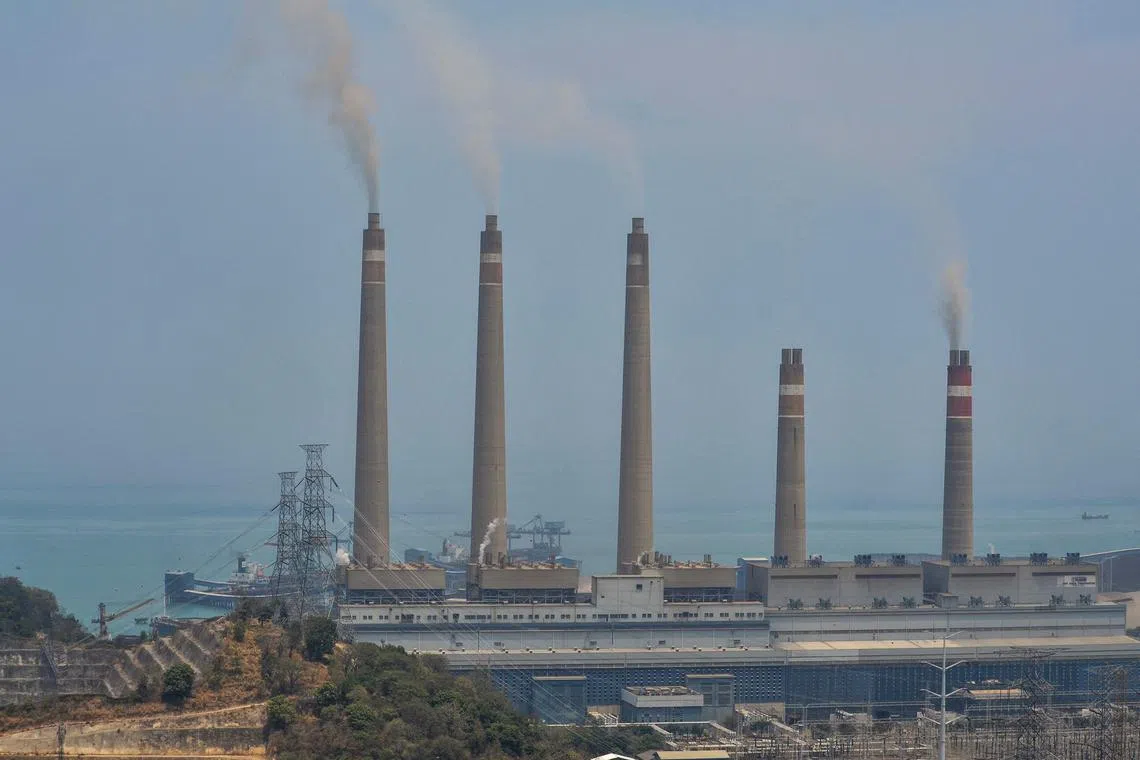Finance, carbon credits key to early coal phase-out in Asia: MAS chief
Sign up now: Get ST's newsletters delivered to your inbox

Coal accounts for almost 60 per cent of the total power generation in the Asia-Pacific.
PHOTO: AFP
Follow topic:
DUBAI - Asia faces a huge challenge shedding its dependency on coal, and needs high-integrity carbon credits and new types of financing to fund early coal plant retirements to reduce global climate risks, Singapore’s central bank chief said on Dec 4.
“Coal is a problem. One out of every six tonnes of greenhouse gas emissions in the world comes from a coal plant in Asia. You want to move the needle, you have got to address this,” Monetary Authority of Singapore (MAS) managing director Ravi Menon told a panel discussion at the Singapore Pavilion on the sidelines of the COP28 United Nations climate conference in Dubai.
While finding ways to retire coal plants is vital, another key focus for the region is modernising and expanding grids to bring wind and solar power to cities and industries across Asia, he added.
Burning coal is the single-largest source of carbon dioxide (CO2) emissions that are heating up the planet, and Asia is by far the largest coal producer and consumer, led by China and India. The fuel is a key source of energy, but also a main cause of deadly air pollution.
There are more than 2,000 coal-fired power plants in the region, and additional power plants will add more CO2 to the air and accelerate global warming. Coal accounts for almost 60 per cent of the total power generation in the Asia-Pacific.
Innovative types of financing are needed to help compensate plant owners and help poorer nations shift to renewable energy, Mr Menon said.
The MAS has been working with the finance sector and other partners to develop the concept of transition credits,
Power plants typically have long-term power purchase agreements with a utility that guarantee revenue for several decades. That revenue stream pays off the debt and earns the owners a profit.
Transition credits arise from emissions reduced through the plant’s early retirement and replacement with cleaner energy sources. Transition finance is an approach that aims to support companies trying to reduce emissions in accordance with a long-term strategy to decarbonise.
“You need a managed phase-out strategy. Not easy to do. Asian coal plants are young, 12 to 15 years on average, and they have another 30 years to go easily,” said Mr Menon.
“Making things worse, they have long-term purchase agreements, and they have policy reliefs. Worse still, in some countries, you have fossil fuel subsidies.”
This makes the economics of early plant retirements especially challenging.
“Why should the coal plant owner give up this revenue stream? Why should the owner shut it down 10 years early?” Mr Menon said.
In some cases, the revenue losses can be quite large. “So, you need to generate carbon credits and to make sure they are high-integrity credits, so that they can be sold and revenue generated to compensate (the owners),” he added.
“But it is easier said than done because carbon credits unfortunately have a bad name today because of a lot of the abuse that has taken place,” he said, adding that they remain an essential part of the solution despite the criticisms.
“The problem is, how do you make them high integrity? So, you have got to make sure that when a coal-fired power plant is shut down on the same grid, you don’t have another coal plant springing up. Because that is carbon leakage.”
Nor should carbon credits be made available to the owner of an uneconomical plant that is going to be shut down anyway. “That is moral hazard,” he said.
Earlier in 2023, MAS and consulting giant McKinsey & Company published a joint working paper. The document explored the conditions for generating high-integrity carbon credits and identified what was needed to develop a market for such credits.
To retire a coal-fired power plant early, it was important to quantify the economic gap and the financing needed for the transaction to be viable, said MAS and McKinsey.
For example, a coal-fired power plant with a 1-gigawatt (GW) capacity would face an economic gap of US$70 million (S$93.5 million) per GW if it was retired five years early, the working paper said.
This economic gap translated to a nominal price of US$11 to US$12 per tonne of greenhouse gases and could potentially be covered by carbon credits.
Financing could also be required, estimated at US$310 million per GW, the paper said.


